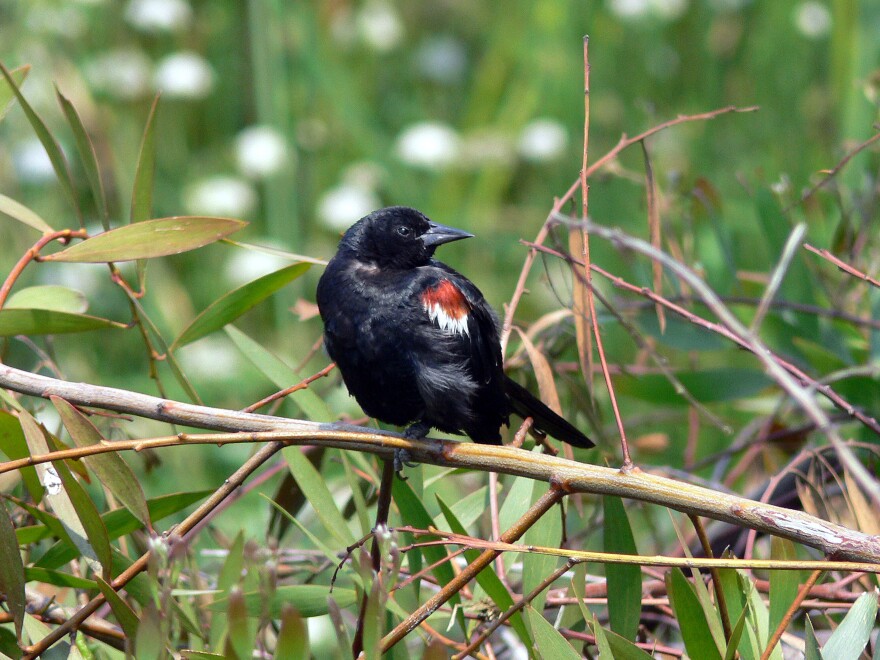The tricolored blackbird, native almost exclusively to Central California, gained protection under the state’s Endangered Species Act in 2018. Since then, the most at-risk colonies have successfully been protected, thanks in large part to San Joaquin Valley dairies.
Sporting distinctive red and white shoulder patches, tricolored blackbirds have a nasal buzzing call that’s sometimes described as cat-like. The tiny birds will spend most of the year in flocks with other blackbird species, then settle during breeding season in the region’s wetlands in “mega-colonies” that number in the tens to hundreds of thousands.
Due to drought and human development, however, the tiny birds have been forced to find new breeding habitat and the population has been in decline. “The population remains at or near its smallest size ever recorded,” reads the 2018 Department of Fish and Wildlife reportthat recommended the bird be protected under the Endangered Species Act. “Coupled with the earlier declines between the 1930s and 1970s, the recent declines have resulted in a population that is a small fraction of its historical abundance.”
For those birds that survived, a new nesting habitat has emerged: Silage fields at dairy farms. For six to eight weeks each spring, the birds settle in stalky rows of triticale, barley, wheat and other grains that dairy producers grow as feed for their cattle.
“They’ve found that these dairy fields are a lot easier to eat from, and there’s usually a barn full of grain next door,” said Merced County dairy producer Simon Vander Woude, who first discovered the birds in his fields in early 2020. “So I have 30,000 birds coming up to my grain piles every day and feeding themselves.”
Similar colonies have materialized at more than a dozen dairies throughout the San Joaquin Valley. “They’re fun to watch fly…it’s like watching a ballet with them up in the air,” said Vander Woude, though he points out the birds can be a nuisance, too. “As I see them fly to my commodity barn, my grain barn, it’s like well, there they go, they’re feeding again, there goes that $300 corn.”
The birds are also in jeopardy if fields are harvested before they’ve left their nest, so Vander Woude is among a small contingent of dairy farmers delaying their harvest to protect them. That can be costly, especially because it pushes back the planting of whatever comes next. “It’s not only the crop that we’re growing right now, it’s delayed planting on the corn crop that goes behind it,” said Vander Woude. “Every week of delay of corn crop generally will diminish the yield of the following crop.”
The Endangered Species Act requires producers to protect tricolored blackbird nests, but a voluntary program helps Vander Woude and others to recoup at least some of their costs. The compensation works out to around $600 per acre. Vander Woude says it’s not enough, but it at least helps support his work toward sustainability. “As an industry, we are stewards of this land,” he said, pointing out that dairies already need to account for other endangered animals including some species of salamanders, kit foxes and hawks. “Biologics need to be part of the story as well. It’s all part of the same system.”
The compensation program came about in 2015 thanks to a partnership between the U.S. Department of Agriculture’s Natural Resources Conservation Service and dairy organizations that was spear-headed by conservation groups. “We approached them and said hey, this conflict is impacting producers and we want to find a solution that is going to benefit everyone,” said Xerónimo Castañeda, a conservation project manager with Audubon California.
Six years in, Castañeda says dairy producers have played a major role in keeping the birds alive. “We’re pretty confident that most years, we’re able to protect 100 percent of at-risk colonies,” he said. “So that’s a big win.”
Although a precise population estimate will have to wait until Audubon California can continue the bird census that has been postponed by the COVID-19 pandemic since 2020, Castañeda says the biologists his organization works with estimate hundreds of thousands of the birds have been protected so far. “We have conservation organizations working alongside agricultural associations to do kind of a win-win, protecting the birds and helping out the producers,” he said. “I think it’s great.”



